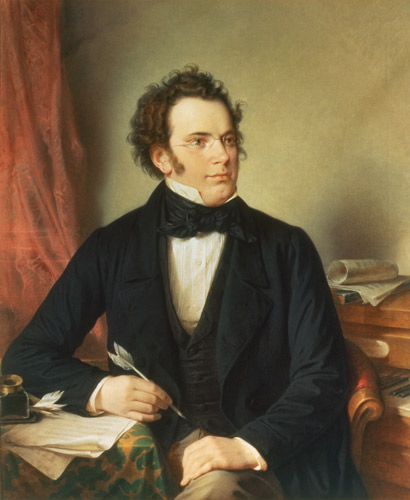Franz Schubert (1797-1828)
Born January 31, 1797 in Vienna (Liechtental), Austria
Died November 19, 1828 in Vienna
Rosamunde Overture Op. 26
Composed in 1820
First Performance: August 19, 1820, at Vienna as the overture to “Die Zauberharfe”
Instrumentation: 2 flutes, 2 oboes, 2 clarinets, 2 bassoons, 4 horns, 2 trumpets, 3 trombones, timpani, strings
Helmina von Chézy (1783-1856), the “writer” who was responsible for the disastrous libretto to Carl Maria von Weber’s opera Euryanthe, convinced Schubert to write incidental music for her play Rosamunde, Fürstin von Zypern (“Rosamunde, Princess of Cyprus”). Even though the premiere was only a few weeks away, Schubert accepted the challenge. He began the composition on November 30 and finished it on December 18 just two days before the December 20, 1823 premiere at the Theater an der Wien, Vienna. Schubert did not have time to write an overture. For the premiere he substituted the D major Overture he wrote in 1822 for the as yet unperformed opera Alfonso and Estrella which was not staged until 1854.
The inept libretto doomed the opera to only two performances. The work disappeared until 1867 when George Grove and Arthur Sullivan found the music in Vienna. Luckily the libretto was not.
It seems that the overture did not satisfy Schubert. In 1825 he arranged the overture to another failed opera Die Zauberharfe (The Magic Harp) for two pianos substituting the title “Overture to the play Rosamunde”. When the Rosamunde Overture was published in 1891 it was this work. Thus the music in the overture has absolutely nothing to do with the incidental music to Rosamunde.
The sonata form overture opens with a slow dramatic introduction in C minor which is followed by the well known first theme in C major.
Example 1. First theme

The introduction and the allegro theme were related to the music in Die Zauberharfe. In the Melodrama No. 3 of the first act the beginning of the introduction is played twice and the allegro theme once. A variant of the introduction introduces the third act.
The contrasting second theme in G is introduced by the clarinets and bassoons.
Example 2. Second theme

An upbeat orchestral tutti which introduces new material follows the second theme.
Example 3. Tutti

The tutti leads into the development in which the themes are not so much developed but rather lightly re-orchestrated. The tutti material returns in the coda which brings the overture to a brilliant close.
Resources
[amazon template=iframe image&asin=B000060MDY][amazon template=iframe image&asin=B003AGPCLI]
